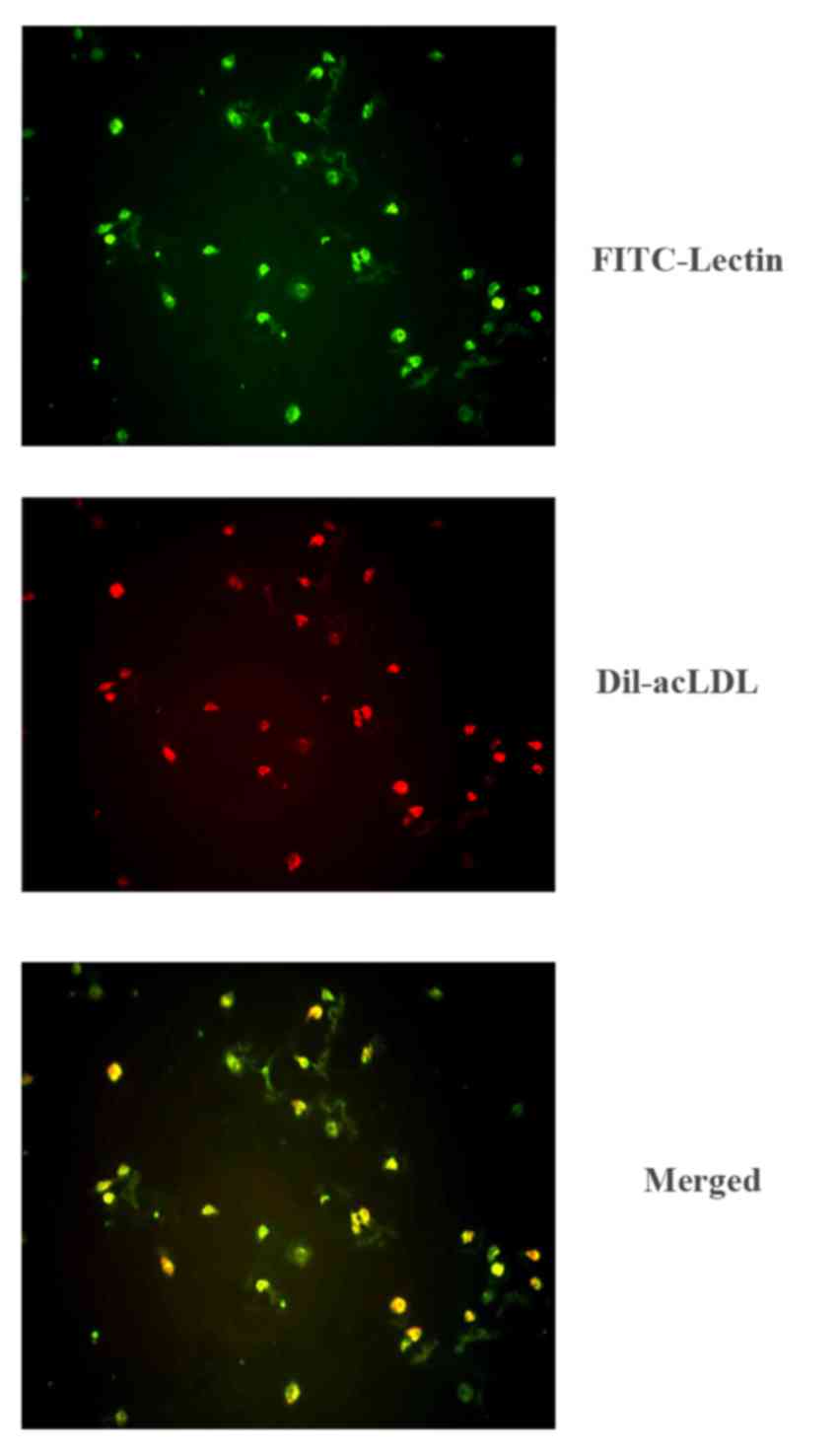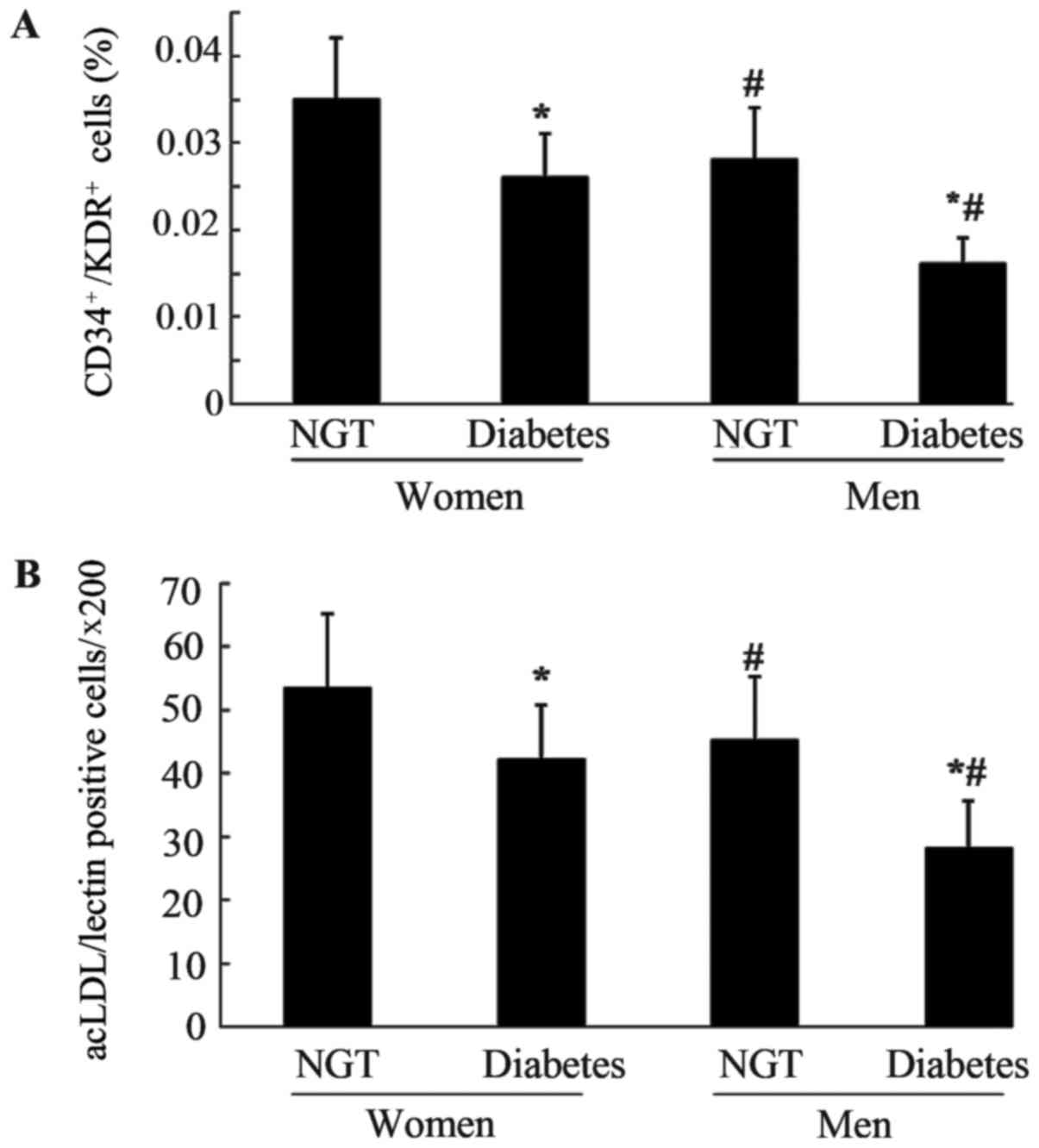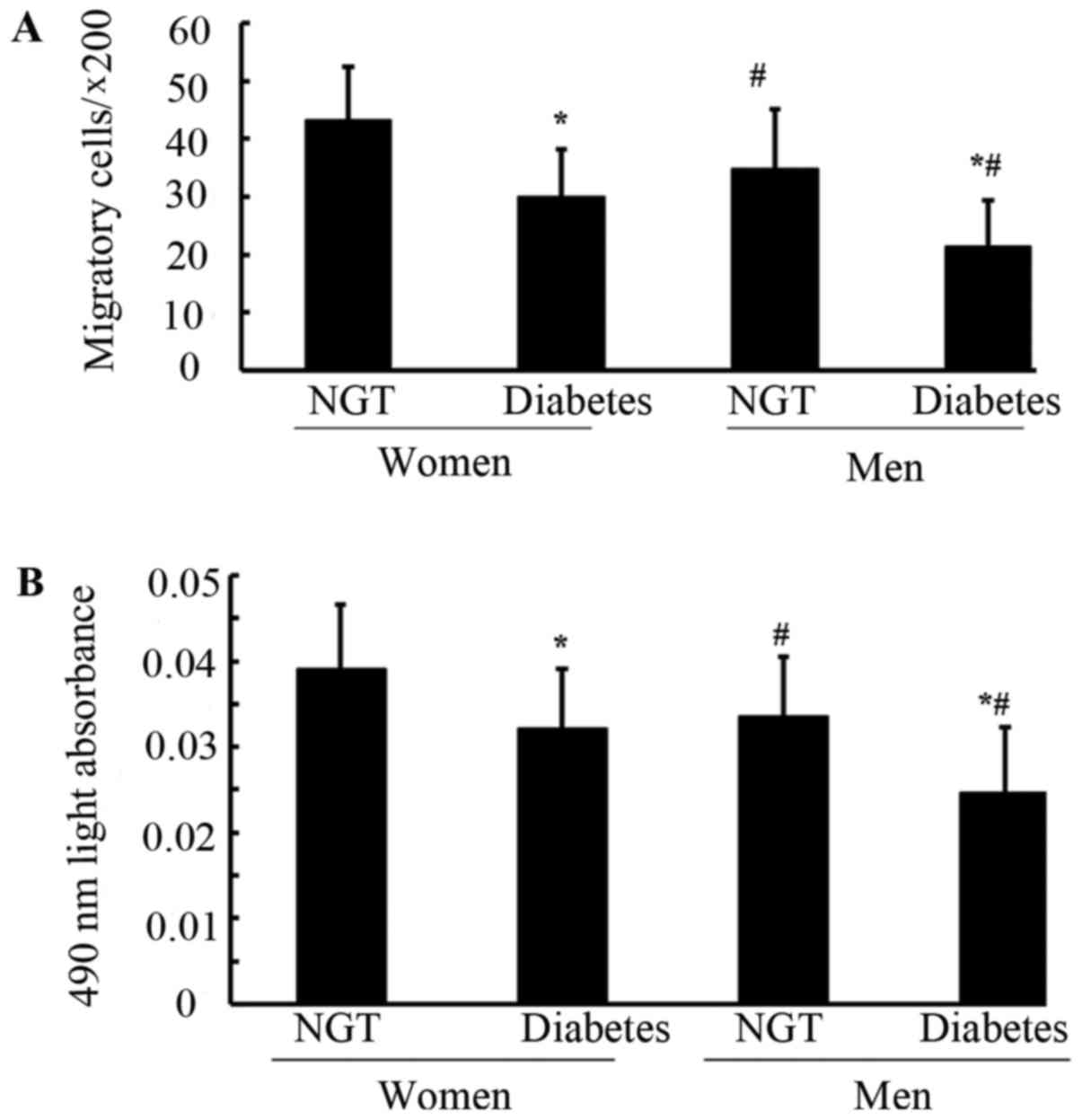|
1
|
Yang W, Lu J, Weng J, Jia W, Ji L, Xiao J,
Shan Z, Liu J, Tian H, Ji Q, et al: Prevalence of diabetes among
Men and Women in China. N Engl J Med. 362:1090–1101. 2010.
View Article : Google Scholar : PubMed/NCBI
|
|
2
|
Avogaro A, de Kreutzenberg SV and Fadini
G: Endothelial dysfunction: Causes and consequences in patients
with diabetes mellitus. Diabetes Res Clin Pract. 82(Suppl 2):
S94–S101. 2008. View Article : Google Scholar : PubMed/NCBI
|
|
3
|
Berezin AE: Endothelial progenitor cells
dysfunction and impaired tissue reparation: The missed link in
diabetes mellitus development. Diabetes Metab Syndr. 11:215–220.
2017. View Article : Google Scholar : PubMed/NCBI
|
|
4
|
Ali M, Mehmood A, Anjum MS, Tarrar MN,
Khan SN and Riazuddin S: Diazoxide preconditioning of endothelial
progenitor cells from streptozotocin-induced type 1 diabetic rats
improves their ability to repair diabetic cardiomyopathy. Mol Cell.
Biochem. 410:267–279. 2015.
|
|
5
|
Jin P, Li T, Li X, Shen X and Zhao Y:
Suppression of oxidative stress in endothelial progenitor cells
promotes angiogenesis and improves cardiac function following
myocardial infarction in diabetic mice. Exp Ther Med. 11:2163–2170.
2016. View Article : Google Scholar : PubMed/NCBI
|
|
6
|
Aicher A, Zeiher AM and Dimmeler S:
Mobilizing endothelial progenitor cells. Hypertension. 45:321–325.
2005. View Article : Google Scholar : PubMed/NCBI
|
|
7
|
Giannotti G, Doerries C, Mocharla PS,
Mueller MF, Bahlmann FH, Horvàth T, Jiang H, Sorrentino SA,
Steenken N, Manes C, et al: Impaired endothelial repair capacity of
early endothelial progenitor cells in prehypertension: Relation to
endothelial dysfunction. Hypertension. 55:1389–1397. 2010.
View Article : Google Scholar : PubMed/NCBI
|
|
8
|
Mandraffino G, Sardo MA, Riggio S,
D'Ascola A, Loddo S, Alibrandi A, Saitta C, Imbalzano E,
Mandraffino R, Venza M, et al: Smoke exposure and circulating
progenitor cells: Evidence for modulation of antioxidant enzymes
and cell count. Clin Biochem. 43:1436–1442. 2010. View Article : Google Scholar : PubMed/NCBI
|
|
9
|
Dong Y, Wu Y, Choi HC and Wang S: Diabetic
endothelium dysfunction, cardiovascular complications, and
therapeutics. J Diabetes Res 2016. 53498012016.
|
|
10
|
Tsai TH, Chai HT, Sun CK, Yen CH, Leu S,
Chen YL, Chung SY, Ko SF, Chang HW, Wu CJ and Yip HK: Obesity
suppresses circulating level and function of endothelial progenitor
cells and heart function. J Transl Med. 10:1372012. View Article : Google Scholar : PubMed/NCBI
|
|
11
|
Hörtenhuber T, Rami-Mehar B, Satler M,
Nagl K, Höbaus C, Höllerl F, Koppensteiner R, Schernthaner G,
Schober E and Schernthaner GH: Endothelial progenitor cells are
related to glycemic control in children with type 1 diabetes over
time. Diabetes care. 36:1647–1653. 2013. View Article : Google Scholar : PubMed/NCBI
|
|
12
|
Fadini GP, Boscaro E, de Kreutzenberg S,
Agostini C, Seeger F, Dimmeler S, Zeiher A, Tiengo A and Avogaro A:
Time Course and Mechanisms of circulating progenitor cell reduction
in the natural history of type 2 diabetes. Diabetes care.
33:1097–1102. 2010. View Article : Google Scholar : PubMed/NCBI
|
|
13
|
De Pascale MR, Bruzzese G, Crimi E,
Grimaldi V, Liguori A, Brongo S, Barbieri M, Picascia A, Schiano C,
Sommese L, et al: Severe type 2 diabetes induces reversible
modifications of endothelial progenitor cells which are ameliorate
by glycemic control. Int J Stem Cells. 9:137–144. 2016. View Article : Google Scholar : PubMed/NCBI
|
|
14
|
Yue WS, Lau KK, Siu CW, Wang M, Yan GH,
Yiu KH and Tse HF: Impact of glycemic control on circulating
endothelial progenitor cells and arterial stiffness in patients
with type 2 diabetes mellitus. Cardiovasc Diabetol. 10:1132011.
View Article : Google Scholar : PubMed/NCBI
|
|
15
|
Sheetz MJ and King GL: Molecular
understanding of hyperglycemia's adverse effects for diabetic
complications. JAMA. 288:2579–2588. 2002. View Article : Google Scholar : PubMed/NCBI
|
|
16
|
Cubbon RM, Mercer BN, Sengupta A and
Kearney MT: Importance of insulin resistance to vascular repair and
regeneration. Free Radical Bio Med. 60:246–263. 2013. View Article : Google Scholar
|
|
17
|
Giacco F and Brownlee M: Oxidative stress
and diabetic complications. Circ Res. 107:1058–1070. 2010.
View Article : Google Scholar : PubMed/NCBI
|
|
18
|
Fox CS: Cardiovascular disease risk
factors, type 2 diabetes mellitus, and the Framingham Heart Study.
Trends Cardiovasc Med. 20:90–95. 2010. View Article : Google Scholar : PubMed/NCBI
|
|
19
|
Garcia NH, Perez HA, Spence JD and Armando
LJ: Risk of vascular disease in premenopausal women with diabetes
mellitus. Clin Ther. 36:1924–1934. 2014. View Article : Google Scholar : PubMed/NCBI
|
|
20
|
Zhen Y, Xiao S, Ren Z, Shen HW, Su H, Tang
YB and Zeng H: Increased endothelial progenitor cells and nitric
oxide in young prehypertensive women. J Clin Hypertens (Greenwich).
17:298–305. 2015. View Article : Google Scholar : PubMed/NCBI
|
|
21
|
Zeng H, Jiang Y, Tang H, Ren Z, Zeng G and
Yang Z: Abnormal phosphorylation of Tie2/Akt/eNOS signaling pathway
and decreased number or function of circulating endothelial cells
in prehypertensive premenopausal women with diabetes mellitus. BMC
Endocr Disord. 16:132016. View Article : Google Scholar : PubMed/NCBI
|
|
22
|
Yang Z, Wang JM, Chen L, Luo CF, Tang AL
and Tao J: Acute exercise-induced nitric oxide production
contributes to upregulation of circulating endothelial progenitor
cells in healthy subjects. J Hum Hypertens. 21:452–460. 2007.
View Article : Google Scholar : PubMed/NCBI
|
|
23
|
Bonafè F, Guarnieri C and Muscari C:
Nitric oxide regulates multiple functions and fate of adult
progenitor and stem cells. J Physiol Biochem. 71:141–153. 2015.
View Article : Google Scholar : PubMed/NCBI
|
|
24
|
Xue J, Du G, Shi J, Li Y, Yasutake M, Liu
L, Li J, Kong Y, Wang S, Yun F and Li W: Combined treatment with
erythropoietin and granulocyte colony-stimulating factor enhances
neovascularization and improves cardiac function after myocardial
infarction. Chin Med J (Engl). 127:1677–1683. 2014.PubMed/NCBI
|
|
25
|
Shurygin MG, Shurygina IA, Dremina NN and
Kanya OV: Endogenous progenitors as the source of cell material for
ischemic damage repair in experimental myocardial infarction under
conditions of changed concentration of vascular endothelial growth
factor. Bull Exp Biol Med. 158:1–531. 2015. View Article : Google Scholar
|
|
26
|
Expert Committee on the Diagnosis and
Classification of Diabetes Mellitus: Report of the expert committee
on the diagnosis and classification of diabetes mellitus. Diabetes
Care. 26(Suppl 1): S5–S20. 2003.PubMed/NCBI
|
|
27
|
Yang Z, Chen L, Su C, Xia WH, Wang Y, Wang
JM, Chen F, Zhang YY, Wu F, Xu SY, et al: Impaired endothelial
progenitor cell activity is associated with reduced arterial
elasticity in patients with essential hypertension. Clin Exp
Hypertens. 32:1–452. 2010. View Article : Google Scholar : PubMed/NCBI
|
|
28
|
Yang Z, Tao J, Wang JM, Tu C, Xu MG, Wang
Y and Pan SR: Shear stress contributes to t-PA mRNA expression in
human endothelial progenitor cells and nonthrombogenic potential of
small diameter artificial vessels. Biochem Biophys Res Commun.
342:1–584. 2006. View Article : Google Scholar : PubMed/NCBI
|
|
29
|
Yang Z, Xia WH, Zhang YY, Xu SY, Liu X,
Zhang XY, Yu BB, Qiu YX and Tao J: Shear stress-induced activation
of Tie2-dependent signaling pathway enhances reendothelialization
capacity of early endothelial progenitor cells. J Mol Cell Cardiol.
52:1–1163. 2012. View Article : Google Scholar : PubMed/NCBI
|
|
30
|
Corretti MC, Anderson TJ, Benjamin EJ,
Celermajer D, Charbonneau F, Creager MA, Deanfield J, Drexler H,
Gerhard-Herman M, Herrington D, et al: Guidelines for the
ultrasound assessment of endothelial-dependent flow-mediated
vasodilation of the brachial artery: A report of the International
Brachial Artery Reactivity Task Force. J Am Coll Cardiol. 39:1–265.
2002. View Article : Google Scholar : PubMed/NCBI
|
|
31
|
Sibal L, Aldibbiat A, Agarwal SC, Mitchell
G, Oates C, Razvi S, Weaver JU, Shaw JA and Home PD: Circulating
endothelial progenitor cells, endothelial function, carotid
intima-media thickness and circulating markers of endothelial
dysfunction in people with type 1 diabetes without macrovascular
disease or microalbuminuria. Diabetologia. 52:1464–1473. 2009.
View Article : Google Scholar : PubMed/NCBI
|
|
32
|
Tsukada S, Masuda H, Jung SY, Yun J, Kang
S, Kim DY, Park JH, Ji ST, Kwon SM and Asahara T: Impaired
development and dysfunction of endothelial progenitor cells in type
2 diabetic mice. Diabetes Metab. 43:154–162. 2017. View Article : Google Scholar : PubMed/NCBI
|
|
33
|
Fadini GP, Sartore S, Agostini C and
Avogaro A: Significance of endothelial progenitor cells in subjects
with diabetes. Diabetes Care. 30:1305–1313. 2007. View Article : Google Scholar : PubMed/NCBI
|
|
34
|
Chen YH, Lin SJ, Lin FY, Wu TC, Tsao CR,
Huang PH, Liu PL, Chen YL and Chen JW: High glucose impairs early
and late endothelial progenitor cells by modifying nitric
oxide-related but not oxidative stress-mediated mechanisms.
Diabetes. 56:1559–1568. 2007. View Article : Google Scholar : PubMed/NCBI
|
|
35
|
Aicher A, Heeschen C and Dimmeler S: The
role of NOS3 in stem cell mobilization. Trends Mol Med. 10:421–425.
2004. View Article : Google Scholar : PubMed/NCBI
|
|
36
|
Shen C, Li Q, Zhang YC, Ma G, Feng Y, Zhu
Q, Dai Q, Chen Z, Yao Y, Chen L, et al: Advanced glycation
endproducts increase EPC apoptosis and decrease nitric oxide
release via MAPK pathways. Biomed Pharmacother. 64:35–43. 2010.
View Article : Google Scholar : PubMed/NCBI
|
|
37
|
Cosentino F, Eto M, De Paolis P, van der
Loo B, Bachschmid M, Ullrich V, Kouroedov A, Delli Gatti C, Joch H,
Volpe M and Lüscher TF: High glucose causes upregulation of
cyclooxygenase-2 and alters prostanoid profile in human endothelial
cells: Role of protein kinase C and reactive oxygen species.
Circulation. 107:1017–1023. 2003. View Article : Google Scholar : PubMed/NCBI
|
















